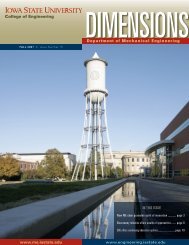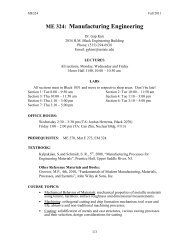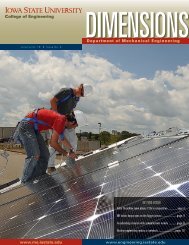Consider-then-Choose Models in Decision-Based Design ...
Consider-then-Choose Models in Decision-Based Design ...
Consider-then-Choose Models in Decision-Based Design ...
You also want an ePaper? Increase the reach of your titles
YUMPU automatically turns print PDFs into web optimized ePapers that Google loves.
Mode Approach for a class of Mathematical Programs with<br />
Complementarity Constra<strong>in</strong>ts”. SIAM Journal on Optimization,<br />
16, pp. 120–145.<br />
[56] Kannan, A., and Shanbhag, U., 2010. “Distributed iterative<br />
regularization algorithms for monotone nash games”. In<br />
Proceed<strong>in</strong>gs of IEEE Conference on <strong>Decision</strong> and Control<br />
(CDC).<br />
[57] Kannan, A., and Shanbhag, U., Forthcom<strong>in</strong>g. “Distributed<br />
computation of equilibria <strong>in</strong> monotone nash games via iterative<br />
regularization techniques”. SIAM Journal on Optimization.<br />
[58] Jongen, H. T., Ruckmann, J. J., and Ste<strong>in</strong>, O., 1997.<br />
“Disjunctive optimization: Critical po<strong>in</strong>t theory”. Journal<br />
of Optimization Theory and Applications, 93(2), May,<br />
pp. 321–336.<br />
[59] Gigerenzer, G., and Gaissmaier, W., 2011. “Heuristic decision<br />
mak<strong>in</strong>g”. Annual Reviews <strong>in</strong> Psychology, 62, pp. 451–<br />
82.<br />
A Several General Screen<strong>in</strong>g Rules<br />
Suppose there are R smooth screen<strong>in</strong>g “functions” σ i =<br />
(σ i,1 ,...,σ i,R ), σ i,r : X × R → R, from which screen<strong>in</strong>g rules<br />
can be derived. A (multiple) conjunctive screen<strong>in</strong>g rule requires<br />
the simultaneous satisfaction of one or more rules <strong>in</strong>dexed by<br />
R = (r 1 ,...,r |R| ) ⊂ {1,...,R} and can be written as the vector<br />
<strong>in</strong>equality<br />
⎡ ⎤<br />
σ i,r1 (x, p)<br />
⎢ ⎥<br />
s i (x, p) = ⎣ . ⎦ ≤ 0;<br />
σ i,r|R| (x, p)<br />
equivalently, s i (x, p) = max r∈R {σ i,r (x, p)} ≤ 0. Disjunctions,<br />
on the other hand, represent the satisfaction of any <strong>in</strong>dividual<br />
rule from some set R ⊂ {1,...,R} and can be written<br />
s i (x, p) = m<strong>in</strong><br />
r<br />
{σ i,r (x, p)} ≤ 0;<br />
(see, e.g., [58]). Disjunctions of conjunctions are maximally general<br />
[30], and require the satisfaction of at least of C conjunctive<br />
rules each def<strong>in</strong>ed as the simultaneous satisfaction of the rules<br />
<strong>in</strong>dexed by R c ⊂ {1,...,R}; i.e.,<br />
s i (x, p) = m<strong>in</strong><br />
c<br />
{<br />
}<br />
max{σ i,r (x, p)} ≤ 0<br />
r∈R c<br />
(see [58]). Subset conjunctive rules, a special case of disjunctions<br />
of conjunctions, require the satisfaction of any fixed number<br />
R ′ of a set of R screen<strong>in</strong>g rules, where R ′ ≤ R. While the<br />
exponential growth <strong>in</strong> the potential number of such rules threatens<br />
to make any model of non-compensatory decision processes<br />
<strong>in</strong>tractable, there is evidence that people tend to use limited, simple<br />
rules <strong>in</strong> their decision-mak<strong>in</strong>g [30, 59].<br />
<strong>Consider</strong> vehicle choice as an example. Suppose x =<br />
(x 1 ,x 2 ,x 3 ) where x 1 is a numeric <strong>in</strong>dex for brand, x 2 is a numeric<br />
<strong>in</strong>dex for body style, and x 3 is a numeric <strong>in</strong>dex for powertra<strong>in</strong><br />
type (Gasol<strong>in</strong>e ICE, Diesel, Hybrid, etc). Let I = 1 (and suppress<br />
<strong>in</strong>dex<strong>in</strong>g with respect to i), R = 3, and suppose<br />
σ 1 (x, p) = −1 if x 1 is “Toyota”, and is +1 otherwise;<br />
σ 2 (x, p) = −1 if x 2 is “sedan”, and is +1 otherwise;<br />
σ 3 (x, p) = −1 if x 3 is “Hybrid”, and is +1 otherwise.<br />
The follow<strong>in</strong>g illustrate the categories of rules discussed above:<br />
The conjunctive rule “I’ll only consider hybrids” is σ 3 (x, p) ≤<br />
0. The negated conjunctive rule “I won’t consider hybrids” is<br />
−σ 3 (x, p) ≤ 0. The conjunctive rule “I’ll consider any Toyota<br />
hybrid” is<br />
s(x, p) =<br />
[ ]<br />
σ1 (x, p)<br />
≤ 0.<br />
σ 3 (x, p)<br />
The disjunctive rule “I’ll consider any Toyota or any hybrid” is<br />
s(x, p) = m<strong>in</strong>{σ 1 (x, p),σ 3 (x, p)} ≤ 0.<br />
The subset conjunctive rule “I’ll consider a Toyota sedan, a Toyota<br />
hybrid, a hybrid sedan, or a Toyota hybrid sedan” is<br />
{<br />
s(x, p) = m<strong>in</strong><br />
max{σ 1 (x, p),σ 2 (x, p)} ,<br />
max{σ 2 (x, p),σ 3 (x, p)} ,<br />
}<br />
max{σ 1 (x, p),σ 3 (x, p)} ≤ 0.<br />
The general disjunction-of-conjunctions rule “I’ll consider a<br />
Toyota hybrid or a sedan” is<br />
{<br />
s(x, p) = m<strong>in</strong><br />
max{σ 1 (x, p),σ 3 (x, p)} , σ 2 (x, p)<br />
}<br />
≤ 0.<br />
B VEHICLE DESIGN AND CHOICE MODELS<br />
Fuel consumption (<strong>in</strong> gpm) and 0-60 acceleration time (<strong>in</strong> s)<br />
are related by<br />
g(a) = 0.035 + 53.5 + 69.5e−a − 1.8a 1.4 + 106.9/a<br />
1000<br />
(24)<br />
16 Copyright c○ 2012 by ASME
















